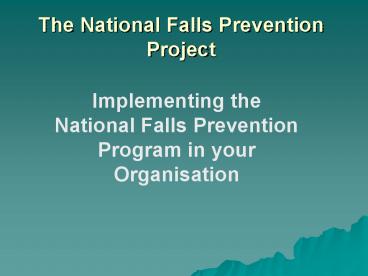The National Falls Prevention Project - PowerPoint PPT Presentation
1 / 21
Title:
The National Falls Prevention Project
Description:
The objective of this program is to enhance the health and well being of the ... Podiatry Assessment and Footwear review. Continence Management. Nutrition review ... – PowerPoint PPT presentation
Number of Views:319
Avg rating:3.0/5.0
Title: The National Falls Prevention Project
1
The National Falls Prevention Project
- Implementing the National Falls Prevention
Program in your Organisation
2
INTRODUCTION
- The National Falls Prevention Program is an
initiative of the Australian Government-
Department of Health Ageing Community Care
3
- The objective of this program is to enhance the
health and well being of the frail aged in the
community and enable them to live as
independently as possible in their own homes - Home and Community Care staff members are an
integral link in the prevention of falls in the
community setting. They play an important role in
health promotion as well as supporting older
people to live as independently as possible in
the community
4
STEP 1- Identify Your Team
- A Co-ordinator- preferably with experience in
falls prevention. - Team should ideally comprise both clinical and
non clinical members - Team members to complete background reading and
training in falls prevention.
5
Step 2-Establish a Meeting Protocol
- Falls Prevention Committee to determine the
direction of your implementation process. - Terms of reference will facilitate progress and
should outline the purpose, objectives and
membership of the team.
6
Step 3-Identify Key Stakeholders
- Internal Stakeholders.
- Your clients, family, carers, home care
workers. - External Stakeholders.
- GPs, Community Allied Health Services.
- Small organisations with limited resources may
need to join with other organisations in your
area to form a partnership committee.
7
Step 4- Establish a Baseline Measure
- Determine what is currently happening in your
Service. - Check what is currently happening in other
Services in your area, so you do not duplicate
services. - Staff survey will help to determine current
levels of awareness in your Service. - An audit of recent falls incidents will provide a
baseline measure, suggest over past 12 months.
8
Step 5- Establishing Priorities
- Once you have baseline data and a profile of
current falls activities you can prioritise your
own area. - Your falls audit may highlight areas of need and
allow you to plan strategies to address these.
9
Step 6-Strategies
- Individual Falls Risk Assessment.
- Identifying Clients at high risk.
- Environmental risk assessment.
10
Strategies
- From the Individual falls risk assessment, the
following strategies may need addressing - Medication review
- Podiatry Assessment and Footwear review
- Continence Management
- Nutrition review
- Vision and Hearing Assessment
- Physical Activity Program.
- Referrals to health professionals
11
Client Capacity Building
- Client to take control and manage own falls
prevention program, with the support of the home
care worker.
12
STEP 7-Prioritise and Implement Strategies
- Determine the process for implementing your
strategies.
13
Step 8- Setting Targets
- Set Performance Targets
- 80 of clients screened on initial assessment
- Evaluate performance targets- chart audit 6
months after inception. - Monitor and correct any identified problems
14
Step 9- Sustainability
- Now you have a specific falls prevention program
running, it is important to sustain it. - It is recommended that you include your
activities in your services policies and
procedures and quality programs. This can then be
used in your HACC review process.
15
Step 9- Sustainability
- Cultural Change- Staff need to recognise the
importance of a falls prevention program and
adopt appropriate actions and strategies into
their work practices in order to sustain the
program. - Continuing education for both clinical and non
clinical staff is essential.
16
Step 10- Evaluation
- Once you have implemented your falls prevention
program, ongoing monitoring is required. - You will need to
- Measure
- Analyse
- Implement.
17
Step 11- Implementing Your Own Falls Prevention
Program
- From the knowledge and skills acquired today,
write an action plan for your service to
implement a falls prevention program.
18
Suggested Model for Service Implementation
- Coordinator will select suitable clients and
introduce them to the project. - Clients will usually be from the following
groups - 1. new clients
- 2. clients referred by home care worker
- 3. clients having a review.
19
Step 12-Service Implementation
- During the Coordinators Home Visit they will
- Explain to the client that the falls prevention
program aims to keep them living safely in their
own home - Explain to the client the 7-Risk Factors.
- Explain to the client how together you can
manage these risks
20
Client Participation
- It is important that the home care worker
explains to the client that participation in the
project is voluntary. - If the client chooses to participate, this can be
recorded in the clients progress notes.
21
Step 13- Implementation and Review
- The Coordinator will action the results of the
questionnaire - The Case Manager will communicate the relevant
outcomes and follow up recommendations with you
through your coordinator. - Report any hazards and concerns to your
coordinator on an ongoing basis































